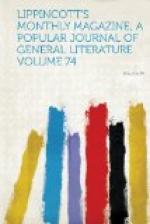This Satanic apotheosis derived no little support from some of the reformer’s idiosyncrasies. He was to his subjects what a rejected claimant of the Messianic office may have been to the Jews—a stone of stumbling and a rock of offence to the people whom he came to bring to a new birth. His civil and ecclesiastical reforms, with the seeming decapitation of the Church by the abrogation of the patriarchate, were to the mass of the people an enigma only one shade less disreputable than the demeanor of himself and his courtiers. The repudiation of his legitimate wife, Eudoxia, and his adulterous connection with a foreign concubine, the death (perhaps by his own hand) of his son Alexis, even the morbid state of his health and the nervous twitching of his face, and his astonishing triumphs after equally incredible disasters, contributed to invest the sombre and gigantic physiognomy of the reformer with a kind of diabolic halo. The vices of Ivan the Terrible had been as monstrous, but even in the thick of his crimes he was a true Russian, as superstitious a devotee as the meanest of his subjects. But the astonishment and bewilderment inspired by Peter the Great were only deepened by the reverence felt by the old Russian for the person of his sovereign. Men could not help doubting whether such a man, who had cast aside his national and scriptural title for the foreign and heathen style of emperor, could be the true, the “white” czar. The story of the usurpers and the false Dmitri had not faded from the popular memory; and thus there grew up amidst the unlettered and bewildered Russian people a string of legends in which were harmonized their belief in the reign of Antichrist and the popular respect for the czar. In this way the Raskolniks have created a fantastic history which has been handed down to our own days, according to one version of which, as has been said, Peter the Great is the impious bastard of the patriarch Nikon (and from such a parentage only a devil’s offspring could be looked for); while another asserts that Peter Alexovitch was a pious prince, like his forefathers, but that he had perished at sea, and in his stead had been substituted a Jew of the race of Danof, or Satan. On gaining possession of the throne, continues the legend, the false czar immured the czarina in a convent, slew the czarovitch, espoused a German adventuress and filled Russia with foreigners. Such is the Old Believers’ explanation of the portentous phenomenon of a Russian czar engaged in destroying the institutions of Holy Russia. In




